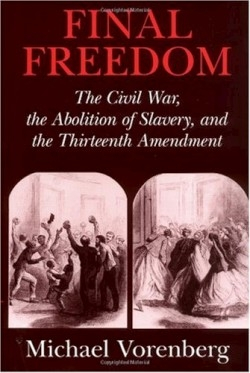Final Freedom
The Civil War, the Abolition of Slavery, and the Thirteenth Amendment
The Emancipation Proclamation did not free a single slave. Actually, freedom was a result of the Union victory and of the passage of the Thirteenth Amendment, a piece of legislation that wasn’t ratified until eight months after the end of the Civil War. In this book, the author examines the amendment in its historical context, using a variety of sources, from legislative proceedings and newspapers to pamphlets and diaries.
Because the debate over the Thirteenth Amendment took place during a national political campaign, the Republicans sought to unite their party behind the amendment and link it to their Presidential candidate, Abraham Lincoln. Vorenberg notes that in the fifty years leading up to the Civil War, Americans rarely contemplated Constitutional amendments, viewing the Constitution almost as a sacred document not to be changed in any way. By the time the Thirteenth Amendment came before Congress in 1864, Americans were willing to amend their Constitution, having come to believe that the original document contained imperfections.
The Republicans who supported the bill advocated the rights of freed slaves to work for wages, to rent or own property, and to marry and bear children, but the Party did not endorse political or social rights, or full citizenship. (Congress had originally proposed a plan whereby former slaves were granted federal rights; for example, former masters who denied their slaves freedom would be subjected to federal fines and imprisonment.)
As Vorenberg clearly shows, the adoption—and implementation—of this amendment was a complex process. In the years after the Civil War, the Supreme Court began to interpret it more restrictively, arguing that it was relevant only in cases of actual slavery, not in cases involving civil rights violations. Finally, in 1906, a ruling declared that the state courts would evaluate violations of the Thirteenth Amendment, thereby eliminating the federal component entirely. Vorenberg concludes that the amendment served as a catalyst for three distinct developments: Americans’ ongoing confrontation with the realities of emancipation; the transformation of the political parties; and Americans’ reconceptualization of their Constitution.
Final Freedom will be of interest to both general historians and Constitutional scholars.
Reviewed by
Rebecca Maksel
Disclosure: This article is not an endorsement, but a review. The publisher of this book provided free copies of the book to have their book reviewed by a professional reviewer. No fee was paid by the publisher for this review. Foreword Reviews only recommends books that we love. Foreword Magazine, Inc. is disclosing this in accordance with the Federal Trade Commission’s 16 CFR, Part 255.

